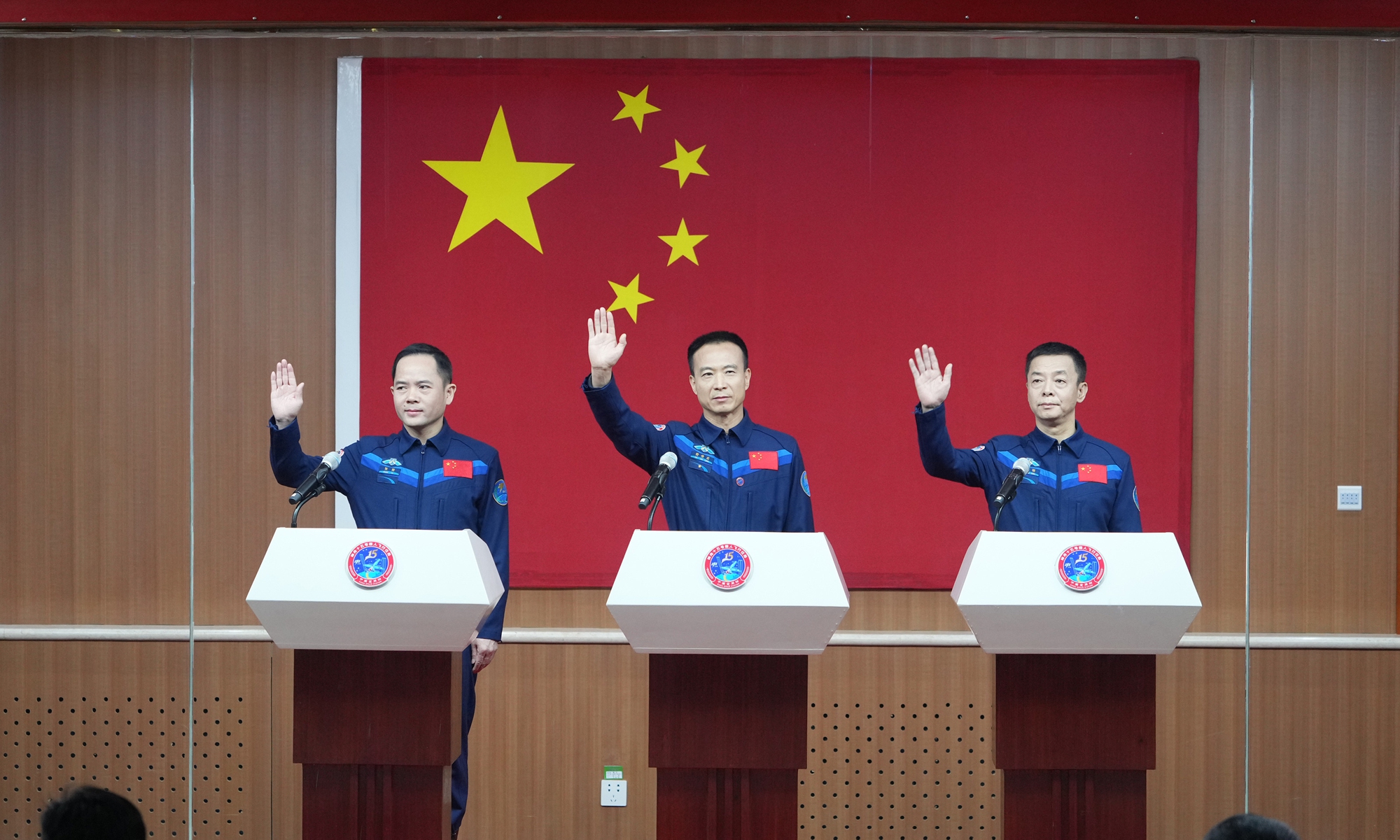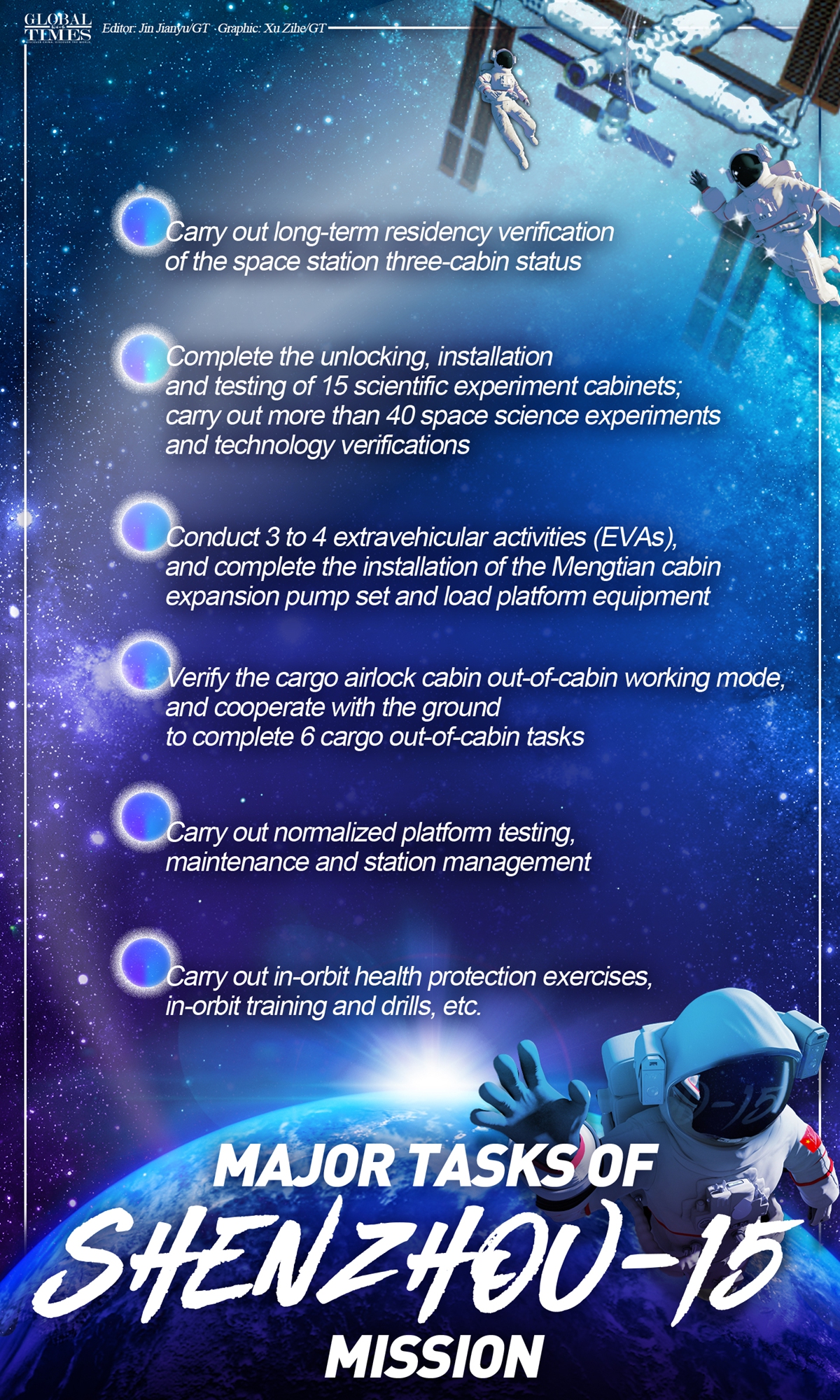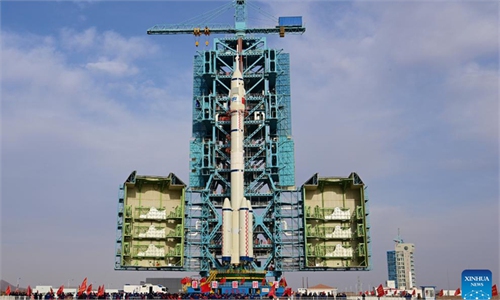Shenzhou-15 crew to visit China Space Station, conduct 1st crew handover in orbit in China's space history

The three taikonauts of the Shenzhou-15 manned spaceflight mission meet with media at a press conference at the Jiuquan Satellite Space Launch Center in Northwest China’s Gansu Province on November 28, 2022. The trio is led by mission commander Fei Junlong (center) with two space newcomers Zhang Lu (left) and Deng Qingming. Photo: Xinhua
China on Monday unveiled the line-up of three taikonauts for Shenzhou-15 manned spaceflight mission that is set to be launched on Tuesday night. The trio led by mission commander Fei Junlong with two space newcomers Deng Qingming and Zhang Lu are going to conduct a direct handover in orbit with the Shenzhou-14 crew at the China Space Station in construction, which shall mark a first in China's aerospace history.
The upcoming Shenzhou-15 crewed spaceflight mission is not only the anchor-leg launch mission at the China Space Station construction stage, but also is the first one to embark on the next operational stage, Fei, the 57-year-old veteran taikonaut who visited the space as the mission commander in the China's Shenzhou-6 mission in 2005, remarked at a press conference on Monday at the Jiuquan Satellite Space Launch Center in Northwest China's Gansu Province.
The crew will carry out more experiments in orbit, operate, maintain and repair relevant equipment and above all execute even more challenging extravehicular activities, or known as spacewalks, with more complicated paths to take on, Fei said on Monday.
The Shenzhou-15 crew has undergone great amount of specific training, which made them very confident to deliver all the set goals and to successfully complete their space run, Fei said.
Deng Qingming, 56, is among the first batch of taikonauts trained in China that includes the country's first astronaut Yang Liwei and also his mission commander Fei in the Shenzhou-15 mission. He has served as a backup for nearly 25 years, in missions such as the Shenzhou-9 and 10, but never got the chance to fly. This will be his first time ever in space.
Zhang Lu, 46, also a new face, was selected in the second batch of taikonauts trained in China in 2010.
Mission insiders told the Global Times on Monday that the two crews of six taikonauts will carry out the space station handover in a face-to-face manner for the first time in the country's manned space history and that is not only of symbolic significance but also carries great practical values to the overall development of the country's first permanent space outpost.
Sources with China's astronaut training system, told the Global Times on Monday that such feat would enable the predecessor Shenzhou-14 to introduce and share what their work and life would be like inside the space station with the new Shenzhou-15 crew directly, boosting the continuity and efficiency of the handover.
It would also help save the resources to set the space station combo from occupied state to unoccupied one and then back again. And the handover will be more target-oriented, especially for those ongoing experiments and space station maintenance work, the sources said.
Having six taikonauts simultaneously onboard the China Space Station in construction, would also verify its performance under the full load condition, which would lay groundwork for future tasks where more payload technicians are needed for more complicated experiments, Song Zhongping, a space watcher and TV commentator, told the Global Times.
By plan, the handover will last for a week or so, and after that, Shenzhou-14 crew will return to the Dongfeng landing site on Earth.
As the temperature drops to somewhere near minus 20 C in Jiuquan around this time of the year, the launch of Shenzhou-15, which is via a Long March-2F rocket from the Jiuquan center, also faces a special challenge of extremely low temperature.
According to the China Academy of Launch Vehicle Technology (CALT), the developer of the Long March-2F rocket, Shenzhou spacecraft had only been launched twice in unscrewed condition during the Shenzhou-1 and 4 missions in late November. Shenzhou-15 would be first one to be carried out with taikonauts onboard in the cold weather.
However, the CALT explained that they have taken such unique challenge into consideration. They have also confirmed the two sets of the temperature system inside the rocket's nose cone, to make sure that the temperature of the propellant of the return and propelling module meets the launch condition.

Major tasks of Shenzhou-15 mission
To-do list
At a press briefing on Monday at the Jiuquan Satellite Launch Center, Ji Qiming, assistant to the China Manned Space Agency (CMSA) director, said that Shenzhou-15 is the final launch during the construction phase of China Space Station, as well as the opening of the application phase of the station.
They will stay in space for six months and return to the ground in May next year. The main objectives of the mission include verifying the space station's ability to support crew rotation and achieving the first in-orbit handover with the Shenzhou-14 members.
According to the mission plan, the Shenzhou-15 spacecraft will conduct a fast, automated rendezvous and docking with the space station combo at Tianhe core module's front port and then form a new combo of three space crafts and three modules.
It will be the largest structure of the China Space Station to date with a total mass of nearly 100 tons.
Major works across the Shenzhou-15 are categorized into six aspects, including the verification of long-term stays in the space station combo, the unlocking, installation and testing of 15 science experiment cabinets and carrying out more than 40 experiments in the fields of space science research and applications, space medicine and space technology, among others.
They will conduct three to four extravehicular activities during the mission to complete extension pump set and platform equipment onboard the Mengtian lab module.
The Shenzhou-15 crew will also verify the exiting of cargo airlock cabin and complete six cargo exiting tasks in cooperation with the ground. They will witness the arrival of the Tianzhou-6 cargo craft and Shenzhou-16 manned spaceship. They will also have a work handover with the Shenzhou-16 crew in orbit.
Open for cooperation
After Mengtian lab module conducted successful transposition in orbit at 9:32 am on November 3, China Space Station has completed its T-shape basic structure assembly in orbit. China has conducted 11 space launches with perfect success rate within 20 months at the space station construction stage and the China Space Station is set to become operational within 2022.
Zhou Jianping, chief designer of China's manned space program, told the Global Times that the life support system of the China Space Station is one of the most advanced innovations onboard and shows China's space strength.
Without the home developed life support system, the crew of three taikonauts would need to consume supplies weighing around 8 tons a year. But now it takes only 400 kilograms, as 95 percent of the supplies including oxygen and water, could be obtained with the help of the life support system, Zhou said.
In addressing international cooperation as it related to the space station, Ji from the CMSA said a number of space science application projects China jointly selected with UNOOSA and ESA are being implemented as planned, and the relevant payloads will begin to enter the Chinese space station next year.
"We have always welcomed astronauts from other countries to enter the China Space Station to conduct experiments. We have received requests from several countries to send astronauts to participate in our space station missions, and we are coordinating with relevant parties and actively preparing for the training of foreign astronauts," Ji said.
On November 1, Zhao Lijian, a spokesperson with the Chinese Foreign Ministry, responded to media inquiries upon the successful docking of Mengtian space lab, the third and final part of China Space Station's three-module structure earlier that day, by saying that China always relies on its own capabilities in its manned space program, and at the same time actively engages the world.
China's Space Station is the first of its kind to be open to all UN member states. So far a number of science experiment projects from 17 countries including Switzerland, Poland, Germany and Italy have been included in the selected projects of China Space Station, Zhao said.


